1994 PONTIAC BONNEVILLE maintenance schedule
[x] Cancel search: maintenance schedulePage 2 of 290
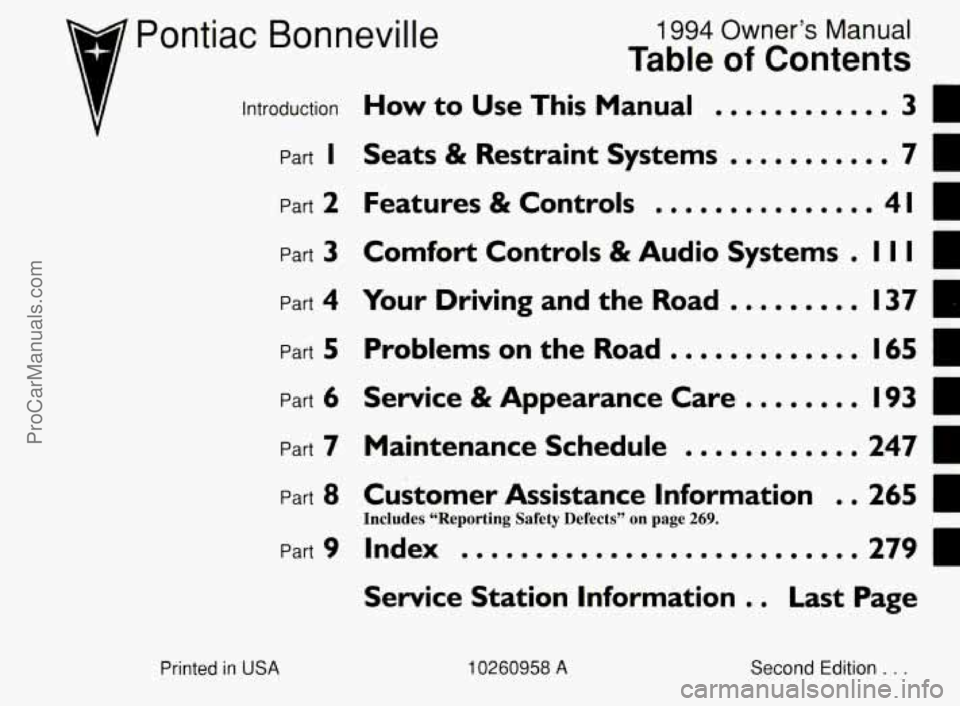
p Pontiac Bonneville
1994 Owner’s Manual
Table of Contents
Introduction HOW to Use This Manual ............
Part I Seats & Restraint Systems ........... 7L
Part 2 Features & Controls ............... 41 c
Part 3 Comfort Controls & Audio Systems . I I I I
Part 4 Your Driving and the Road ......... 137 E
Part 6 Service & Appearance Care ........ 193 I
Part 5 Problems on the Road ............. 165
Part 7 Maintenance Schedule ............ 247 E
Part 8 Customer Assistance Information . . 265
Part9 Index ........................... 279 I
Includes “Reporting Safety Defects” on page 269.
Service Station Information . . Last Page
Printed in USA 10260958 A Second Edition ...
ProCarManuals.com
Page 4 of 290
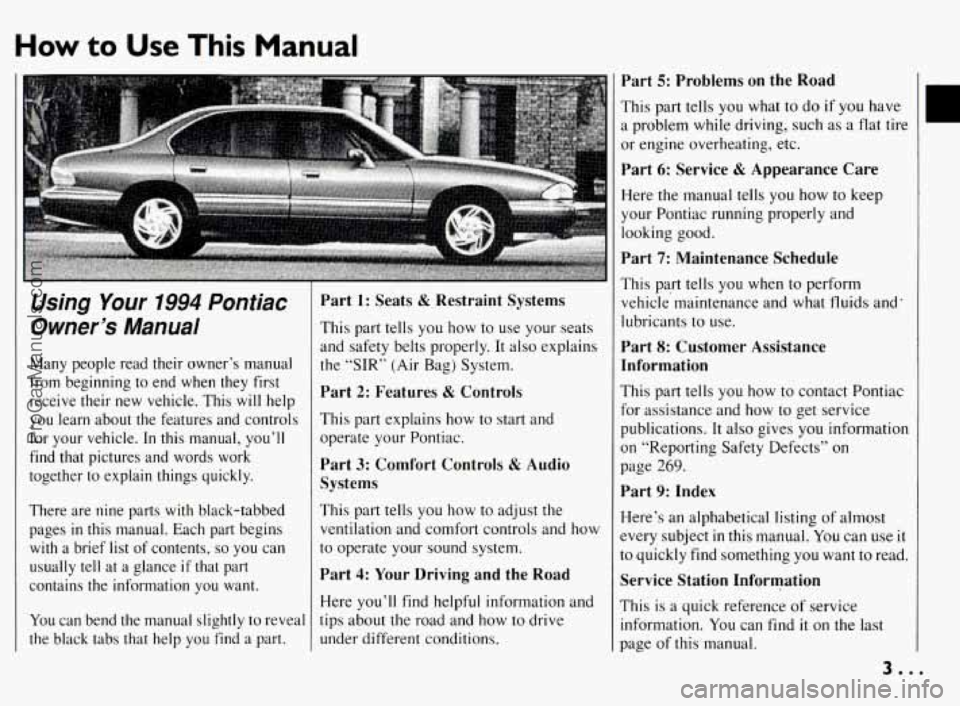
How to Use This Manual
Using Your 1994 Pontiac
Owner’s Manual
Many people read their owner’s manual
from beginning
to end when they first
receive their
new vehicle. This will help
you learn about the features and controls
for your vehicle. In this manual, you’ll
find that pictures and words work
together
to explain things quickly.
There are nine parts with black-tabbed pages
in this manual. Each part begins
with a brief list of contents,
so you can
usually tell at a glance
if that part
contains the information you want.
You can bend the manual slightly to reveal
the black tabs that help you find a part.
This part tells you how to use your seats
and safety belts properly. It also explains
the “SIR’ (Air Bag) System.
Part 2: Features & Controls
This part explains how to start and
operate your Pontiac.
Part 3: Comfort Controls & Audio
Systems
This part tells you how to adjust the
ventilation and comfort controls and how
to operate your sound system.
Part 4: Your Driving and the Road
Here you’ll find helpful information and
tips about the road and how
to drive
under different conditions.
Part 5: Problems on the Road
This part tells you what to do if you have
a problem while driving, such as a flat tire
or engine overheating, etc.
Part 6: Service & Appearance Care
Here the manual tells you how to keep
your Pontiac running properly and
looking good.
Part 7: Maintenance Schedule
This part tells you when to perform
vehicle’maintenance and what fluids and’
lubricants to use.
Part 8: Customer Assistance
Information
This part tells you how to contact Pontiac
for assistance and how
to get service
publications. It also gives
you information
on “Reporting Safety Defects”
on
page 269.
Part 9: Index
Here’s an alphabetical listing of almost
every subject
in this manual. You can use it
to quickly find something you want to read.
Service Station Information
This is a quick reference of service
information.
You can find it on the last
page of this manual.
3..
ProCarManuals.com
Page 164 of 290
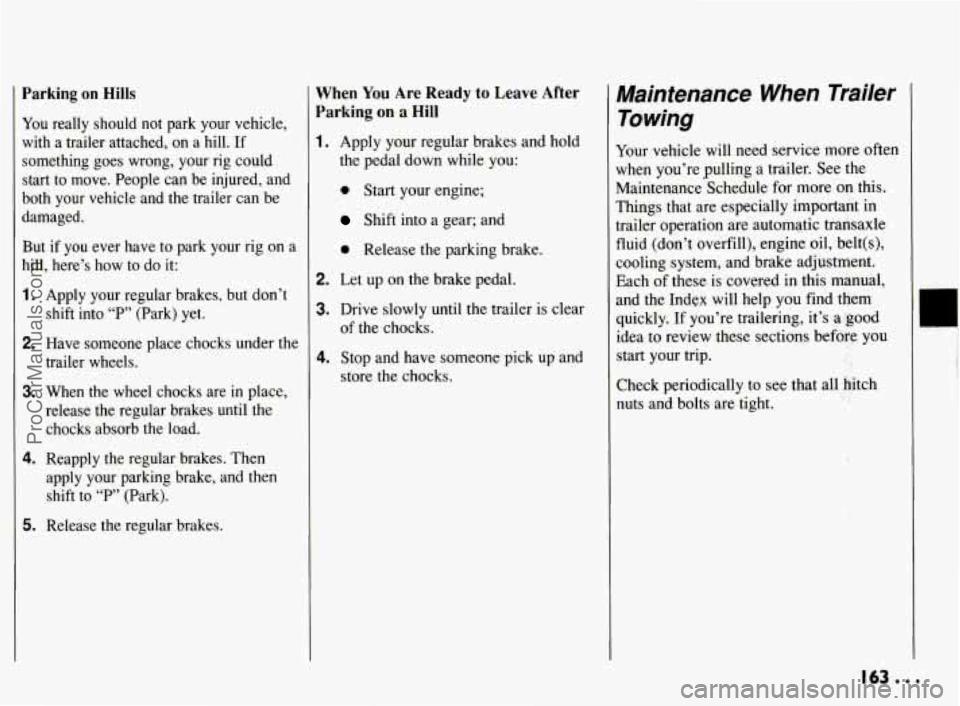
Parking on Hills
You really should not park your vehicle,
with a trailer attached, on a hill.
If
something goes wrong, your rig could
start to move. People can be injured, and
both your vehicle and the trailer can be
damaged.
But if you ever have to park your rig on a
hill, here’s how to do it:
1.
2.
3.
4.
5.
Apply your regular brakes, but don’t
shift into
“P” (Park) yet.
Have someone place chocks under the
trailer wheels.
When the wheel chocks are in place,
release the regular brakes until the chocks absorb the load.
Reapply the regular brakes. Then
apply your parking brake, and then shift to
“F”’ (Park).
Release the regular brakes.
When You Are Ready to Leave After
Parking
on a Hill
1.
2.
3.
4.
Apply your regular brakes and hold
the pedal down while you:
0 Start your engine;
Shift into a gear; and
0 Release the parking brake.
Let up on the brake pedal.
Drive slowly until the trailer is clear
of the chocks.
Stop and have someone pick up and
store the chocks.
Maintenance When Trailer Towing
Your vehicle will need service more often
when you’re pulling a trailer.
See the
Maintenance Schedule for more
on this.
Things that are especially important in
trailer operation are automatic transaxle
fluid (don’t overfill), engine oil, belt(s),
cooling system, and brake adjustment,
Each
of these is covered in this manual,
and the Index will help you find them
quickly. If you’re trailering, it’s a good
idea to review these sections before. you
start your trip.
Check periodically to
see that all hitch
nuts and bolts are tight.
,j.;
i .a
1. i
,
.?.
163...
ProCarManuals.com
Page 204 of 290
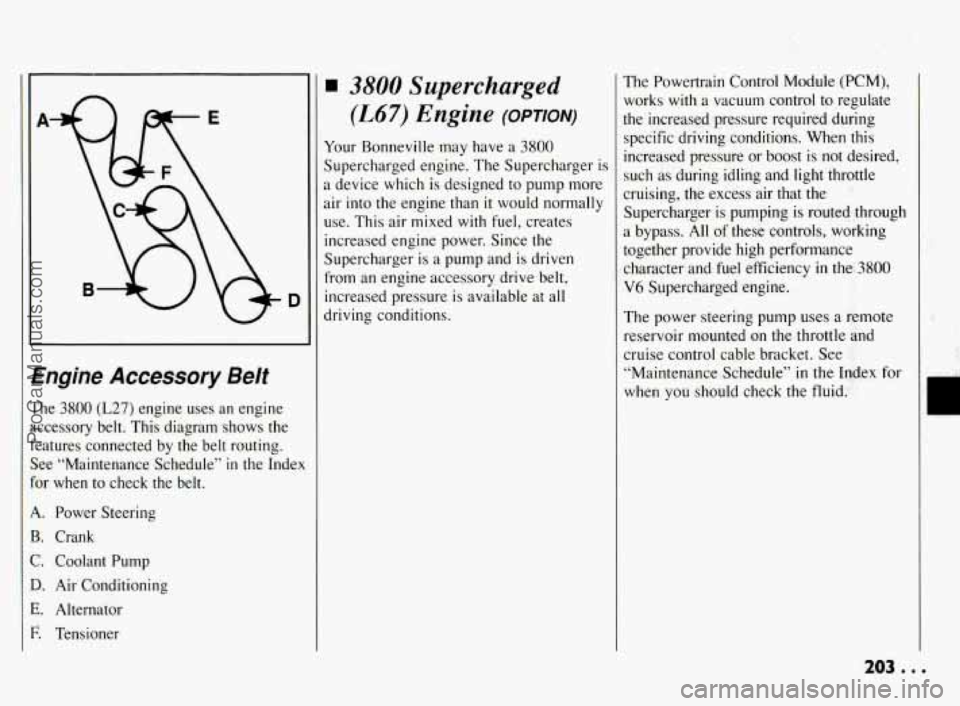
n
D
~~ ~~~ ~~ ~ ~~~~ ~ ~ ~
Engine Accessory Belt
The 3800 (L27) engine uses an engine
accessory belt. This diagram shows the
features connected by the belt routing.
See “Maintenance Schedule’’
in the Index
for when to check the belt.
A. Power Steering
B. Crank
C. Coolant Pump
D. Air Conditioning
E. Alternator
F. Tensioner
3800 Supercharged
(L67) Engine (OPTION)
Your Bonneville may have a 3800
Supercharged engine. The Supercharger is
a device which is designed to pump more
air into the engine than
it would normally
use. This air mixed
with fuel, creates
increased engine power. Since the
Supercharger is a pump and is driven
from an engine accessory drive belt,
increased pressure is available at all
driving conditions, The Powertrain Control
Module
(PCM),
works with a vacuum control to regulate
the increased pressure required during
specific driving conditions. When this
increased pressure or boost is
not desired,
such as during idling and light throttle
cruising, the excess air that the
’
Supercharger is pumping is routed,through
a bypass. All of these controls, working
together provide high performance
character and fuel efficiency
in the3800
V6 Supercharged engine.
The power steering pump uses a Remote
reservoir mounted on the throttle wd
cruise control cable bracket. See
“Maintenance Schedule”
in the Index for
when you should check the fluid:
ProCarManuals.com
Page 205 of 290
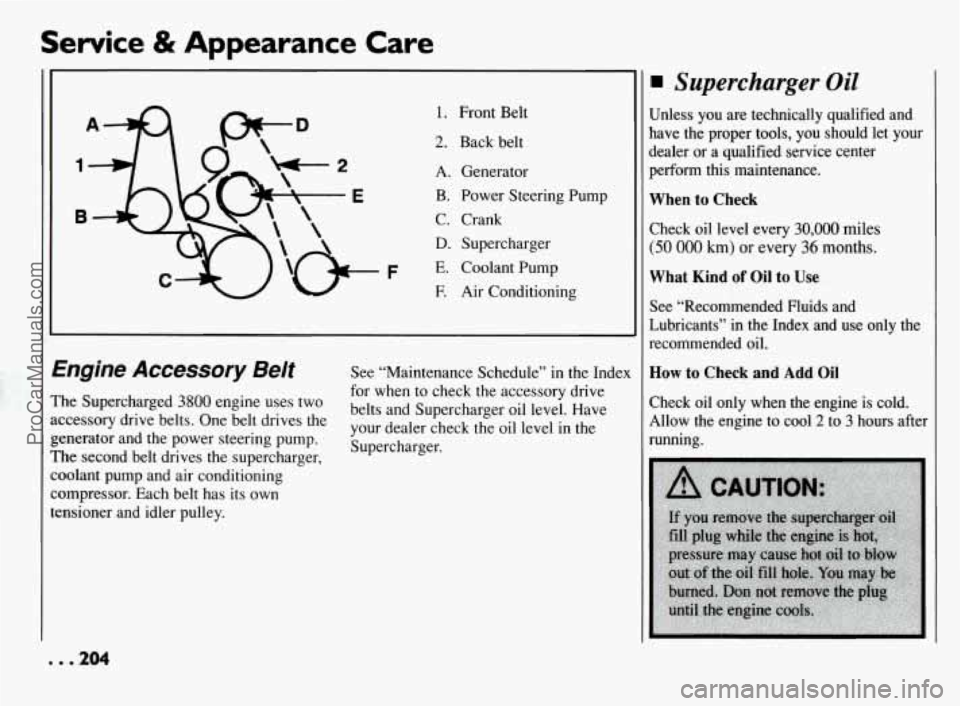
Service & Appearance Care
F
1.
2.
A.
B.
C.
D.
E.
E
Front Belt
Back belt
Generator
Power Steering Pump
Crank Supercharger
Coolant Pump
Air Conditioning
tngine Accessory Belt
‘he Supercharged 3800 engine uses two
ccessory drive belts. One belt drives the
enerator and the power steering pump.
‘he second belt drives the supercharger,
oolant pump and air conditioning
ompressor. Each belt has its own
msioner and idler pulley.
. . 204
See “Maintenance Schedule” in the Index
for when to check the accessory drive
belts and Supercharger oil level. Have
your dealer check the oil level in the
Supercharger.
Supercharger Oil
Unless you are technically qualified and
have the proper tools, you should let your
dealer or a qualified service center
perform this maintenance.
When to Check
Check oil level every 30,000 miles
(50 000 km) or every 36 months.
What Kind of Oil to Use
See “Recommended Fluids and
Lubricants” in the Index and use only the
recommended oil.
How to Check and Add Oil
Check oil only when the engine is cold.
Allow the engine to cool
2 to 3 hours after
running.
ProCarManuals.com
Page 210 of 290
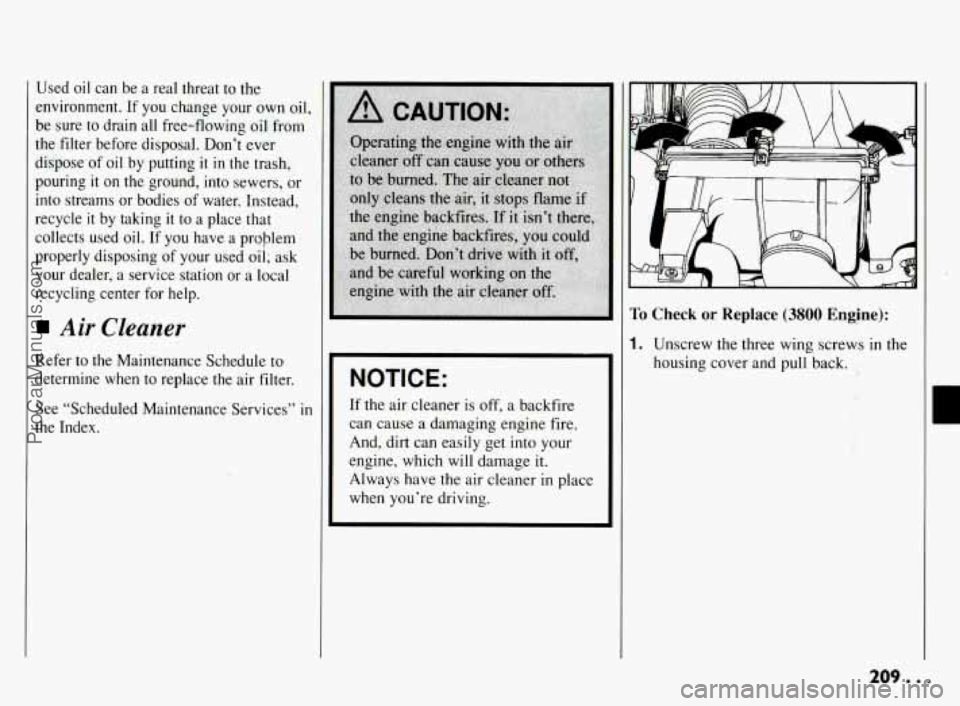
Used oil can be a real threat to the
environment. If you change your own oil,
be sure to drain all free-flowing oil from
the filter before disposal. Don’t ever
dispose of oil by putting
it in the trash,
pouring it on the ground, into sewers, or
into streams or bodies of water. Instead,
recycle
it by taking it to a place that
collects used oil.
If you have a proplem
properly disposing of your used oil; ask
your dealer, a service station or a local
recycling center for help.
Air Cleaner
Refer to the Maintenance Schedule to
determine when to replace the air filter.
See “Scheduled Maintenance Services” in
the Index.
NOTICE:
If the air cleaner is off, a backfire
can cause a damaging engine fire.
And, dirt can easily get into your
engine, which will damage it.
Always have the air cleaner in place
when you’re driving.
To Check or Replace (3800 Engine):
1. Unscrew the three wing screws in the
housing cover and pull back.
t
209.. .
ProCarManuals.com
Page 212 of 290
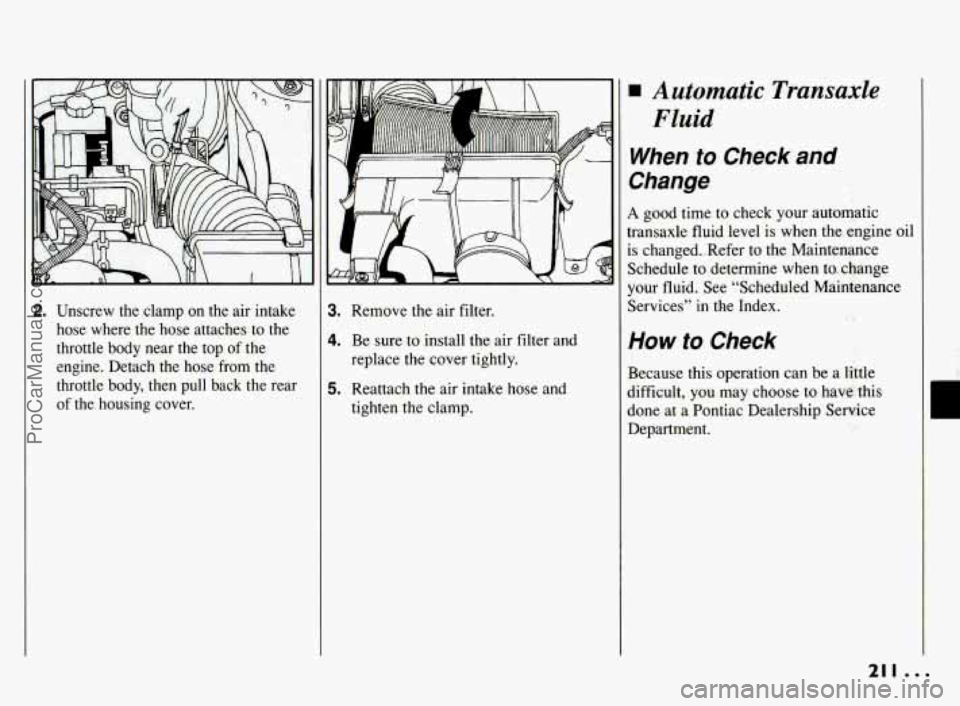
2. Unscrew the clamp on the air intake
hose where the hose attaches to the
throttle body near the top
of the
engine. Detach the hose from the
throttle body, then pull back the rear
of the housing cover.
3. Remove the air filter,
4. Be sure to install the air filter and
replace the cover tightly.
5. Reattach the air intake hose and
tighten the clamp.
Automatic Transaxle
Fluid
When to Check and
Change
A good time to check your automatic
transaxle fluid level is when the engine oil
is changed..Refer to the Maintenance
Schedule to determine when to. change
your fluid. See “Scheduled Maintenance
Services”
in the Index.
How to Check
,- , .. : : j! ? !i
Because this operation can be a little
difficult,
you may choose to have this
done at a Pontiac Dealership Service
Department.
211 b..
ProCarManuals.com
Page 214 of 290
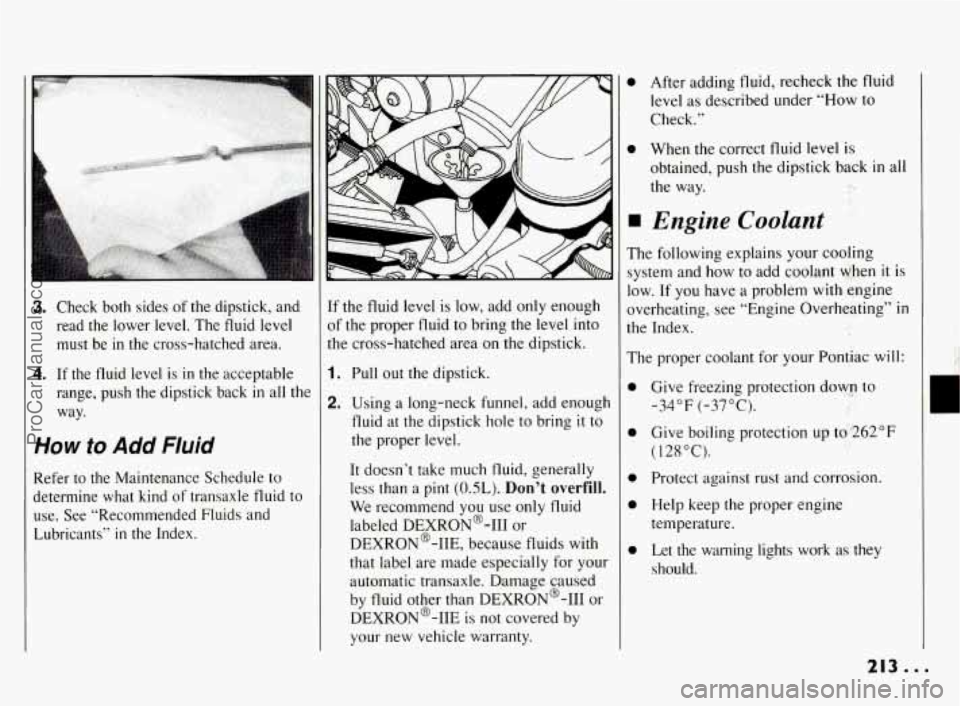
3. Check both sides of the dipstick, and
read the lower level. The fluid level must be in the cross-hatched area.
4. If the fluid level is in the acceptable
range, push the dipstick back in all the
way.
How to Add Fluid
Refer to the Maintenance Schedule to
determine what kind of transaxle fluid to
use. See “Recommended Fluids and
Lubricants’’
in the Index. If
the fluid level is low, add only enough
of the proper fluid to bring the level into
the cross-hatched area on the dipstick.
1. Pull out the dipstick.
2. Using a long-neck funnel, add enough
fluid at the dipstick hole to bring
it to
the proper level.
It doesn’t take much fluid, generally
less than a pint
(OSL). Don’t overfill.
We recommend you use only fluid
labeled DEXR0N’-I11
or
DEXRON@-IIE, because fluids with
that label are made especially for your
automatic transaxle. Damage caused
by fluid other than DEXRON@-I11 or
DEXR0N’-IIE is not covered by your new vehicle warranty.
0 After adding fluid, recheck the fluid
level as described under “How to
Check.”
0 When the correct fluid level is
obtained, push the dipstick back in all
the way. ..
Engine Coolant
The following explains your cooling
system and how to add coolant when
it is
1.0~. If
you have a problem with engine
overheating, see “Engine Overheating” in
the Index.
The proper coolant for your Pontiac will:
0
0
0
0
0
Give freezing protection down to
-34°F (-37°C).
Give boiling protection up to
,262”F
( 128 “C).
Protect against rust and corrosion.
Help keep the proper engine
temperature.
Let the warning lights work as they should.
r
213...
ProCarManuals.com